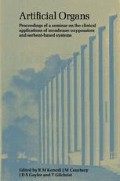Summary
Hepatic failure and the eventual hepatic coma form a complex pathophysiological state, the aetiology of which remains in most cases undefined and for which treatment has yet to be established. The functions of the liver may be grouped for discussion into those of detoxification and metabolism. Since the function of detoxification is most notable in the early stages of hepatic failure, most attention has been directed to this method of treatment. The rationale for this approach stems from the ability of the liver to regenerate itself and therefore eventually provide total support. However, methods of detoxification alone are limiting and are not sufficient where extended periods of support are necessary, therefore, the need to provide active metabolic activity. For this purpose, liver tissue was chosen. Studies on the procurement and preparation of liver tissue in the form of slices were carried out and the preparation evaluated both in incubation chambers and in specially constructed perfusion devices. Studies have indicated the active function of these preparations for various metabolic processes.
Preview
Unable to display preview. Download preview PDF.
References
Fischer, J. E. (1974). Hepatic coma in cirrhosis, portal hypertension and following portacaval shunt. Arch. Surg., 108, 325.
Gazzard, B. G., Weston, M. J., Murray-Lyon, I. M., Flax, H., Record, C. O., Portman, B., Langley, P. G., Dunlop, E. H., Mellon, P. J., Ward, M. B. and Williams, R. (1974). Charcoal haemoperfusion in the treatment of fulminant hepatic failure. Lancet 1, 1301.
Kiley, J. E., Welch, H. F., Pender, J. C. and Welch, C. S. (1956). Removal of blood ammonia by haemodialysis. Proc. Soc. Exp. Biol. Med., 91, 489.
Koshino, I., Castino, F., Yoshida, K., Carse, C., Kambic, H., Scheucher, K., Kretz, A. P., Malchesky, P. S. and Nosé, Y. (1975). Biological extracorporeal metabolic device for hepatic support. Trans. Amer. Soc. Artif. Int. Organs 21, 492.
Mikami, J. and Nosé, Y. (1959). Surgical treatment of acute liver failure. An experimental study of extracorporeal metabolism in the artificial liver using slices of canine liver. Jap. J. Gastroenterol., 56, 1022.
Nosé, Y., Koshino, I., Castino, F., Yoshida, K. Carse, G., Kambic, H., Scheucher, K., Kretz, A. P. and Malchesky, P. S. (1975). Further assessment of liver tissue materials for extracorporeal hepatic assist, in R. Williams and I. M. Murray- Lyon (Eds.), Artificial Liver Support, Pitman Medical, London.
Schechter, D. C., Nealon, T. F. and Gibbon, J. H. (1958). A simple extracorporeal device for reducing elevated blood ammonia levels. Preliminary report. Surgery, 44, 892.
Schenker, S., Breen, K. J. and Hoyumpa, A. M. (1974). Hepatic encephalopathy. Current status. Gastroenterology, 66, 121.
Soyer, T., Lempinen, M. and Eiseman, B. (1973). In vitro extracorporeal liver slices and cell suspensions for temporary hepatic support. Ann. Surg., 177, 393
Editor information
Editors and Affiliations
Copyright information
© 1977 Bioengineering Unit, University of Strathclyde
About this chapter
Cite this chapter
Nosé, Y., Malchesky, P.S., Koshino, I., Castino, F., Scheucher, K. (1977). Hepatic Assist 1: Use of Liver Tissue in an Extracorporeal Device. In: Kenedi, R.M., Courtney, J.M., Gaylor, J.D.S., Gilchrist, T., Gerard, S.M. (eds) Artificial Organs. Strathclyde Bioengineering Seminars. Palgrave, London. https://doi.org/10.1007/978-1-349-03458-1_41
Download citation
DOI: https://doi.org/10.1007/978-1-349-03458-1_41
Publisher Name: Palgrave, London
Print ISBN: 978-1-349-03460-4
Online ISBN: 978-1-349-03458-1
eBook Packages: Biomedical and Life SciencesBiomedical and Life Sciences (R0)

